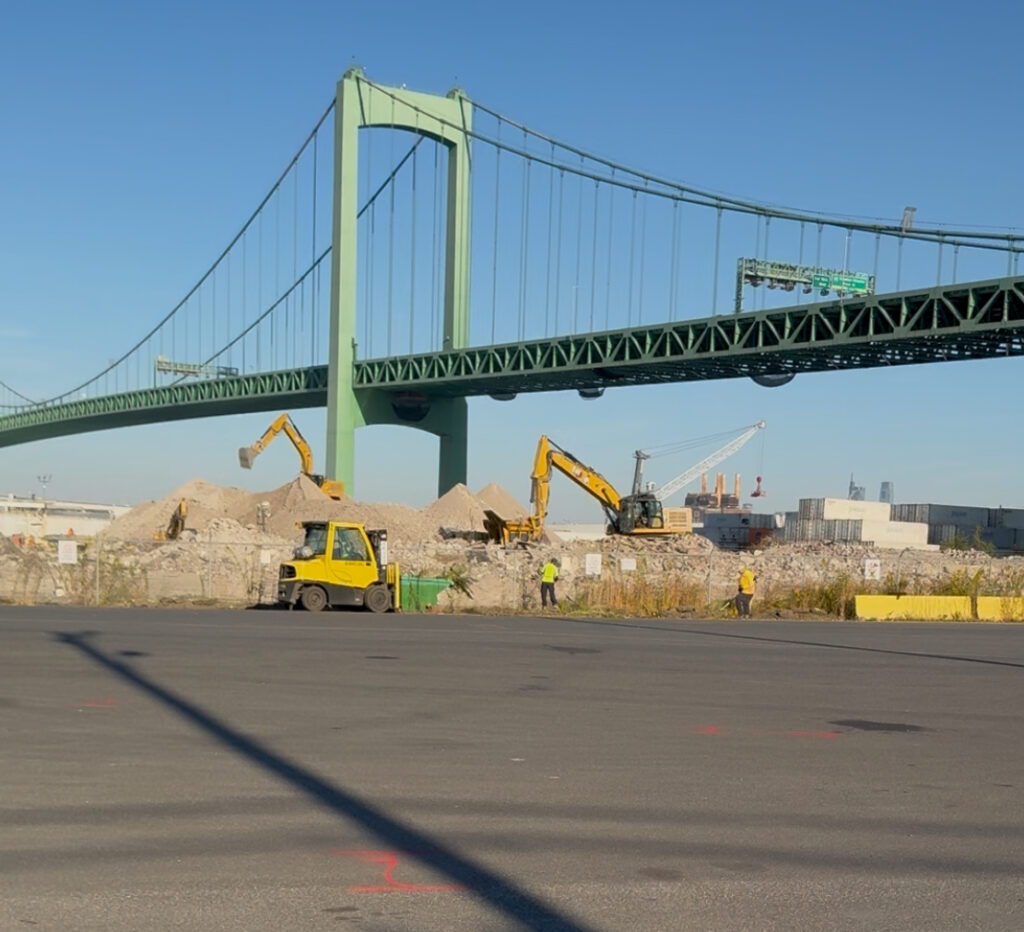EPA AGENCY SAYS CANCER RISKS ARE LOWER THAN OR WITHIN ACCEPTABLE RANGES AT FORMER WELSBACH FACTORY

GLOUCESTER CITY, NJ (OCTOBER 5, 2025)(CNBNews)–Earlier this year the U.S. Environmental Protection Agency approved proposed changes to its 1999 cleanup plan to address contaminated radiological material at the former Welsbach facility (FWF) located within the footprint of the Gloucester Marine Terminal, in Gloucester City, New Jersey. The changes to the cleanup plan will address previously unknown and changed site conditions at the port facility that led the EPA to determine that implementing the 1999 cleanup plan was no longer possible. Specifically, those previously unknown site conditions include significant increases in the volume and depth of contaminated material.

Workers continue to demolish buildings that once was the home of the Welsbach factory, now the Holt Marine Terminal at King and Essex Streets. (CNBNews photo)
The key components of the changes to the 1999 cleanup plan include:
Excavation of radiologically contaminated soil and waste materials from selected areas at the port facility, as well as under port facility buildings constructed over Welsbach fill areas and other permanent structures to a depth of approximately 10 feet below ground surface (bgs) and disposal off-site;
Backfill of excavated areas with clean fill;
Restoration of paved areas to previous conditions; and
Implementation of deed restrictions to control access to remaining radiologically contaminated soil and waste materials.
The cleanup plan will not remove all the radiologically impacted soil/waste material (below approximately 10 feet) in two selected open areas and in locations under several buildings and other permanent structures; contamination under structures that are critical to port operations would remain in place until the building/structure is removed by the port owner/operator.
The EPA has performed risk assessments to show that leaving this contaminated material at depth and below buildings does not pose an unacceptable risk to building occupants or port workers. The Welsbach Company manufactured gas mantles at its facility in Gloucester City, New Jersey, starting around 1895. Welsbach imported monazite ore, which contains the radioactive element thorium, to use as a key material in its production process. The extracted thorium allowed the mantles to glow brightly when heated. By the early 20th century, Welsbach had become the largest producer of gas mantles and lamps in the U.S., with production reaching up to 250,000 mantles per day. It was located at the present-day Holt Terminal complex, King and Essex Streets.
General Gas Mantle (GGM) was a smaller competitor located in Camden, NJ, operating from 1912 to 1941. Welsbach ceased operations in 1940. During its years of production, the leftover material from processed ore, which still contained radioactive elements, was used as fill material throughout Gloucester City. This fill was also incorporated into the construction of residential and commercial buildings, as well as in low-lying areas around the Welsbach facility.
Over the past century, several Welsbach buildings have been demolished. The debris from these buildings may also have been used as fill in the Gloucester City area. The EPA initially identified the site while investigating the U.S. Radium Corporation Superfund site in Orange, NJ, as records indicated that the U.S. Radium Corporation purchased radium from Welsbach. In 1981, the EPA conducted an aerial radiological survey of the Camden and Gloucester City area to assess potential radioactive contamination, ultimately identifying six study areas. In 1996, the Welsbach/GGM site was placed on the Superfund National Priorities List.
image above provided by EPA
Background
What Has Been Done to Clean Up the Site?
What Is the Current Site Status?
On related pages:
Operable Units
Cleanup Progress